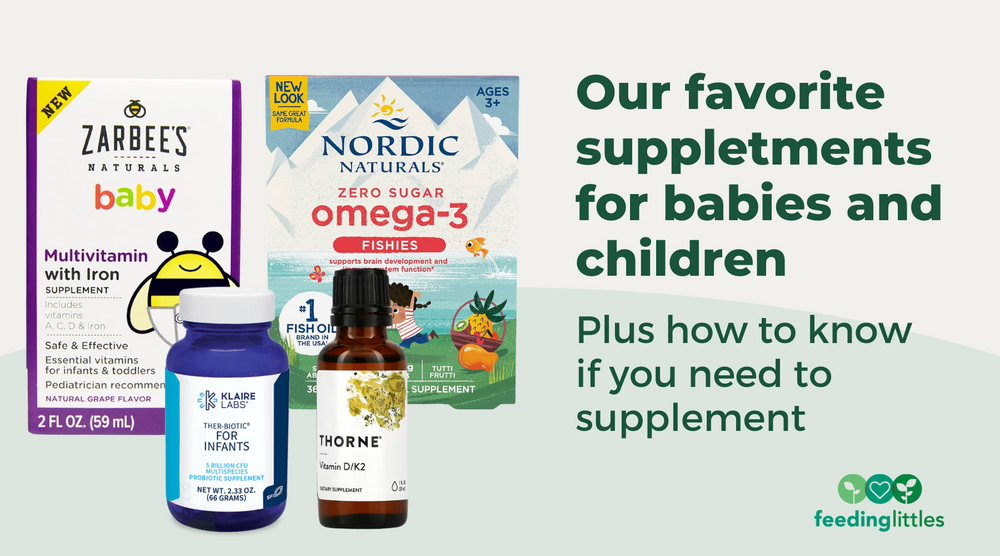
Supplements are always a hot topic with our clients. We are constantly asked what supplements we recommend for kids.
Here’s our short, main message:
The only supplement most babies and kids all the way to age 18 likely need is vitamin D, per the AAP. However, in certain circumstances supplementation may be warranted, especially if your child’s diet is very limited or if you offering a supplement helps you minimize the pressure you put on your child to eat.
Here are some additional considerations:
- Please check with your child’s pediatrician before giving your child any supplement. The recommendations in this post are informational only and do not replace medical or personalized recommendations.
- Ideally, all of your child’s nutrition would come from food – the exception to this in most cases is vitamin D (see below). The AAP doesn’t recommend routine supplementation except for vitamin D. Supplements can have a place in your child’s diet, but if you are really struggling with their nutrition please take our Infant or Toddler & Kid courses too. We want infants and children to receive most of their nutrition from what they’re eating/drinking, not from supplements, unless your child has specific medical or developmental needs.
- If you are looking to supplement, it’s important to keep a few things in mind when looking for a product. Keep an eye out for what you don’t want: too much. More isn’t always better. Unless your provider recommends supplementing for a deficiency, choose supplements that are less than 100% of the RDA/RDI (Recommended Dietary Allowance) per serving. In addition, look for brands that describe purity standards, clearly list ingredients that are easy to pronounce, and are widely available or available through medical providers.
- This list is by no means exhaustive or all-inclusive. There are so many products out there – these are simply the products we have used and feel good about. If you love the product you’re taking and it’s available to the greater public (not via direct sales), feel free to reach out to us so we can review it.
- This list is not specific to any medical conditions or nutrient deficiencies. If you need more personalized help, please work with your pediatrician or pediatric dietitian.
- If you click to the links in this post we will receive a small commission, at no cost to you. This allows us to continue to recommend products and put together resources utilizing our professional expertise. Thank you for using these links!

Vitamin D
Vitamin D is traditionally known for promoting strong bone growth, as it helps the body utilize calcium, but newer research also suggests that optimal vitamin D status may help prevent chronic diseases like asthma, cardiovascular disease and cancer. The best source of vitamin D is sunlight. However, since sunscreen use is important for skin cancer prevention, coupled with our indoor lifestyles, most people are vitamin D deficient.
Interestingly, vitamin D is the only supplement routinely recommended by the American Academy of Pediatrics. Specifically:
- “Breastfed and partially breastfed infants should be supplemented with 400 IU a day of vitamin D beginning in the first few days of life.” (Feeding Littles edit: new research suggests that if a breastfeeding mom is taking 6400 IU vitamin D a day, supplementation is not necessary. This amount is about 8x what is in a traditional prenatal or multivitamin. It is not unsafe to take 6400 IU yourself and supplement baby with vitamin D concurrently if you are worried about baby’s vitamin D status.)
- Formula-fed or combo-fed infants who are consuming less than 32 ounces per day of vitamin D-fortified formula should receive a vitamin D supplement of 400 IU a day.
- Children and adolescents who do not get 600 IU of vitamin D per day through foods should receive a vitamin D supplement. This amount is found in 6 cups of vitamin D fortified milk – far too much milk for most kids to drink.
- “Children with an increased risk of vitamin D deficiency, such as those taking certain medications and with chronic diseases such as cystic fibrosis, may need higher doses of vitamin D. Consult your pediatrician.”
What does this mean?
Essentially, every child should receive a vitamin D supplement throughout infancy and childhood, unless they are getting at least 32 oz of formula as a baby or if they’re breastfeeding and mom is taking 6400 IU vitamin D herself. Again, kids 12+ months need 600 IU per day, an amount that is very difficult to obtain through food. They would need to drink 48 ounces of fortified milk – far too much!
Can't my child just eat vitamin D-rich foods?
Yes, but many of these foods aren't necessarily fan favorites when it comes to kids, or they would have to eat a lot of them to meet their needs. Here are some great food sources of vitamin D:
- 4 ounces salmon = 600 IU vitamin D (100% of a kid's daily value)
- 4 ounces canned sardines = 220 IU vitamin D (37% of a kid's daily value)
- 1 cup fortified milk = 100 IU vitamin D (17% of a kid's daily value)
- 1/2 cup mushrooms = 68 IU vitamin D (11% of a kid's daily value)
- 1 egg yolk = 37 IU vitamin D (6% of a kid's daily value)
Vitamin D is the sun vitamin. Can't my child just get it from the sun?
We know that some parents are uncomfortable with supplementation and think that children should get all they need from their food. While we agree with this philosophy to a certain extent, vitamin D may be the exception. When children were tested for vitamin D status, over 70% were considered insufficient. Vitamin D, especially when given in very simple supplements, is a safe and effective way to help build strong bones and prevent chronic disease. If you decide not to supplement your child, we recommend annual vitamin D testing to ensure they're getting enough sun exposure.
When looking for a vitamin D supplement, watch ingredient lists. There are many very simple options available – no need for tons of ingredients or preservatives. If your child takes a multivitamin (see below) that contains 400-600 IU vitamin D or more, you do not need a separate vitamin D supplement.
Vitamin D3 is the form of vitamin D most often found in over-the-counter supplements. It’s derived from animal sources, whereas vitamin D2 is derived from plant sources. While vitamin D3 might be more absorbable than vitamin D2, most physicians agree that what matters most is taking vitamin D in supplemental form when needed instead of worrying about the form or type of vitamin D.
Here are some products we recommend:
Infants (under 12 months):
Thorne Vitamin D/K2 – 500 IU per drop (vitamin K2 can help with vitamin D absorption)
Carlson Labs Baby’s Super Daily D3 – 400 IU per drop
UpSpring Baby Vitamin D3 Drops – 400 IU per drop
Nordic Naturals Vitamin D Drops – 400 IU per drop
Baby D Drops – 400 IU per drop
Mommy’s Bliss Vitamin D Drops – 400 IU per drop
Zarbee’s Natural’s Vitamin D Supplement – 400 IU per 0.25 mL
Toddlers/Kids (12+ months)
(Note: you can also offer 2 drops of the 400 IU vitamin D drops listed above if you don’t have a 600 IU drop. The established Upper Limit for vitamin D in kids is 2,500 IU, so having a double dose of the infant drop – 800 IU – is considered safe.)
D Drops Booster – 600 IU per drop
Joy Spring Vitamin D Drops (with vitamin K2) – 1000 IU per 5 drop serving (600 IU per 3 drops)
Renzo’s Dynamite D3 – 1,000 IU per tab
Mary Ruth’s Vitamin D Spray – 800 IU per 4 spray serving (600 IU per 3 sprays)

Iron
Iron is a mineral that helps carry oxygen from the lungs to every muscle in the body. Iron-deficiency in kids can be mild to severe. Severe deficiency can lead to issues with growth and brain development, so iron deficiency is something providers take seriously.
Babies receive iron in breast milk and iron-fortified formula, although their iron needs go up starting at age 7 months. Because of this, babies need more iron than what they can get from breast milk or formula in the second half of infancy. This is why we recommend high-iron foods every day when you start complementary foods (6+ months) – because babies need that extra iron.
High-iron foods include: beef, poultry, fish, whole grains, iron-fortified grains and cereals, leafy greens, nut and seed butters, beans and lentils.
How do I know if my child needs an iron supplement?
Your provider will likely do a blood test to check your baby’s iron level at your 12 month appointment. Most babies and kids do not need supplemental iron if they’re getting iron in food, but if your baby was premature or has an increased risk of iron-deficiency, your provider might recommend an iron supplement. Oftentimes, providers recommend raising iron levels with food first.
If you’re worried about your child’s iron status, talk to your provider.
Some iron supplements can have a really unfavorable taste. We’ve included products that seem to be well-liked by our clients.
Here are some products we recommend if supplemental iron is indicated:
Infants (under 12 months):
Novaferrum Pediatric Drops Liquid Iron for Infants and Toddlers
Toddlers/Kids (12+ months)
Novaferrum Pediatric Drops Liquid Iron for Infants and Toddlers
Renzo’s Iron Strong with Vitamin C – 2+ years

Multivitamins
Most parents assume their kids need a multivitamin to be healthy. However, research suggests that multivitamins are best used when children exhibit a deficiency, not as a catch-all for every kid. Yes, kids don’t always eat a balanced diet, but unless they are deficient in certain nutrients they probably do not need a multivitamin.
However,…sometimes adding a multivitamin to a toddler’s or child’s routine can help parents stress less (and thus lay off the pressure) at mealtime, especially if the child is especially picky. Some conditions also increase a child’s need for a multivitamin. And since we do know kids probably need a vitamin D supplement, a multivitamin containing vitamin D is a one-two punch.
What about babies? We generally do not recommend a routine multivitamin for full-term, healthy infants unless indicated by their provider. They simply need supplemental vitamin D if not getting enough of it in their milk (see above).
Here are some products we recommend if supplementation is indicated:
Infants (Under 12 months) – includes 400 IU vitamin D:
(Reminder: most infants do not need a multivitamin – these products are suggestions if a multivitamin is suggested by their provider):
Mommy’s Bliss Baby Multivitamin + Iron
NovaFerrum Multivitamin with Iron for Infants and Toddlers
NovaFerrum Vegan Multivitamin with Iron for Infants and Toddlers
SmartyPants Baby Multi + DHA
Zarbee Baby Multivitamin
Toddlers (1-3 years):
Contains enough vitamin D (600 IU):
Zarbee’s Toddler Multivitamin – recommended for ages 2-3, watch for choking safety with gummies and brush teeth after offering
Does not contain enough vitamin D – an additional 400 IU vitamin D drop or at least 2 cups fortified milk/milk alternative are recommended with these products:
NovaFerrum Multivitamin with Iron for Infants and Toddlers
NovaFerrum Vegan Multivitamin with Iron for Infants and Toddlers
SmartyPants Baby Multi + DHA
SmartyPants Toddler Formula Gummies with Omega-3s – recommended for ages 2-3, watch for choking safety with gummies and brush teeth after offering
Renzo’s Picky Eater Multivitamin with Iron – 1/2 tablet for kids ages 2-3
Kids (4+ years) – Includes at least 600 IU vitamin D:
Many of the kids multivitamins that contain the nutrient ratios we prefer come as gummies. We recommend brushing your child’s teeth afterwards if offering gummies.
Garden of Life Vitamin Code Multivitamin for Kids
SmartyPants Kids Multivitamin – includes omega-3s
SmartyPants Kids Organic Multivitamin – includes omega-3s and probiotics
Renzo’s Picky Eater Multivitamin with Iron – 2 tablets for kids ages 4+

Probiotics
Probiotics are such a hot topic right now, as more and more research is emerging to suggest the importance of a healthy gut flora. The recommendations below are simply a few general high-quality probiotics that we use and love.
Probiotics are the live bacteria and other organisms that live in our GI tract and various parts of our body. They are responsible for fighting off invaders as part of the immune system defense and may play a role in disease prevention, gut health, skin health, and neurological function.
In general, if your baby is breastfeeding or is using a formula that contains probiotics, additional probiotics are not necessary. However, if you baby has taken antibiotics, is exposed to a lot of germs at daycare or while traveling, or has any skin or digestive upset it is generally considered safe to start a probiotic to see if it helps. If your child has any medical conditions or is immunocompromised, please talk to your doctor first.
What about probiotics for toddlers and older children? If your toddler or child doesn’t have breast milk, yogurt, kefir, sauerkraut, kim chi other fermented foods a few times a week, a probiotic may be a good idea. This might especially be the case if your child struggles with constipation (or diarrhea), eczema or skin issues, uses antibiotics, or seems to get sick often. Again, check with your doc!
Below are some products we like – again, there are MANY probiotics out there, but these are the ones we’ve used the most. We prefer probiotics with at least 3-5 billion CFU (colony forming units) per serving and at least 4 different bacterial strains, but not every probiotic will fit that bill.
What should I do if my child needs to be on antibiotics?
We love using Florastor Kids during antibiotic use because it’s made from S. boulardii, a yeast strain not killed by antibiotics. S. boulardii can help prevent antibiotic-induced diarrhea.
Florastor Kids should be used during antibiotic regimens, as S. boulardii can help prevent antibiotic-induced diarrhea. It's not meant to be used as a regular probiotic. The probiotic strain in Florastor is a yeast, not a bacteria, so it’s not killed by the antibiotic.
Some probiotics need to be shipped and stored refrigerated. Carefully read product labels to ensure proper storage. In general, probiotics can be put in a bottle, stirred into food or put on a nursing mother’s nipple. Some families also put probiotics on a clean finger directly into baby’s mouth.
Here are some products we recommend if supplementation is indicated:
Infants (under 12 months):
Klaire Ther-Biotic For Infants
Garden of Life Baby Probiotics
Toddlers/Kids (12+ months):
Klaire Ther-Biotic Children’s Chewable – age 2+ due to the capsule size/chewing requirement
Lovebug Probiotic and Prebiotic for Kids
Mary Ruth’s Organic Probiotic Drops
Garden of Life Organic Kids Probiotics
HyperBiotics Pro Kids

Omega-3s
EPA and DHA are essential fatty acids present in breast milk, formula, fatty fish and (in much less bioavailable quantities) flax seeds, walnuts, and chia seeds. DHA specifically is responsible for eye and brain development and serves as a potent anti-inflammatory agent in the body, potentially helping in management of asthma, ADHD, and in prevention of heart disease later in life. If your baby or child is breastfeeding or is using formula containing DHA, or if your child is eating fatty fish like salmon or sardines a few times a week, supplementation is not necessary.
However, using an omega-3 supplement for toddlers and kids probably cannot hurt and can help ensure that your child consumes omega-3 fats, which are otherwise somewhat hard to get in high doses in the diet if your child doesn’t eat fatty fish. Some eggs and milk are fortified with omega-3s, but it may be more cost effective to use a supplement. We love Nordic Naturals brand, as they are incredibly transparent in their processing of fish and algae oils and remove any contaminants or heavy metals utilizing molecular distillation.
While the guidance is mixed, on average we recommend approximately 100 mg per day of DHA via the form of food or supplements. Again, if your child is breastfeeding or drinking a DHA-fortified formula, or if they eat fatty fish or DHA-fortified foods regularly, they probably do not need a supplement. However, unless contraindicated by your physician it likely does not hurt, especially after your baby weans from breast milk or formula.
Here are some products we recommend if supplementation is indicated:
Infants (under 12 months)
Again, infants do not need DHA if they’re breastfeeding or receiving fortified formula. If you decide to offer extra DHA, we recommend waiting until at least 6 months.
Nordic Naturals Baby’s DHA
Toddlers/Kids (12+ months):
Nordic Naturals Children’s DHA Strawberry
Nordic Naturals Children’s DHA Gummies

I hope this post helped you dissect the complicated world of supplements and find a product that works for you!
And in case you were wondering, I personally give my girls Thorne Vitamin D/K2 (1 drop), Klaire Children’s Chewable probiotic (1 chewable) if they’re not eating many probiotic foods, and Nordic Naturals Omega-3 Fishies (1 gummy) if they’re not eating vey much fatty fish.
